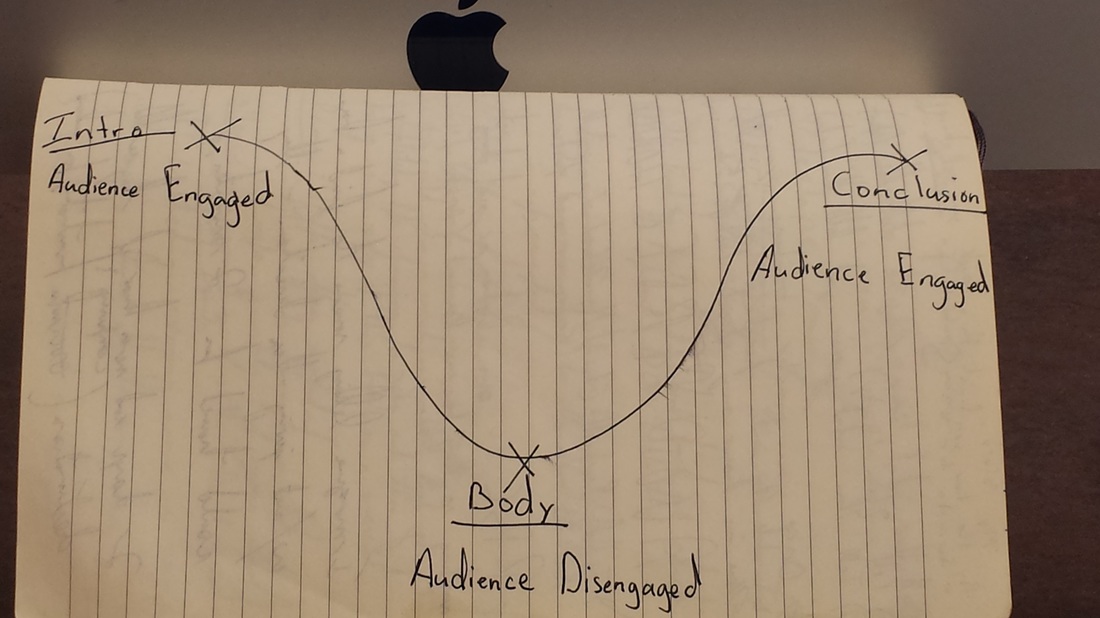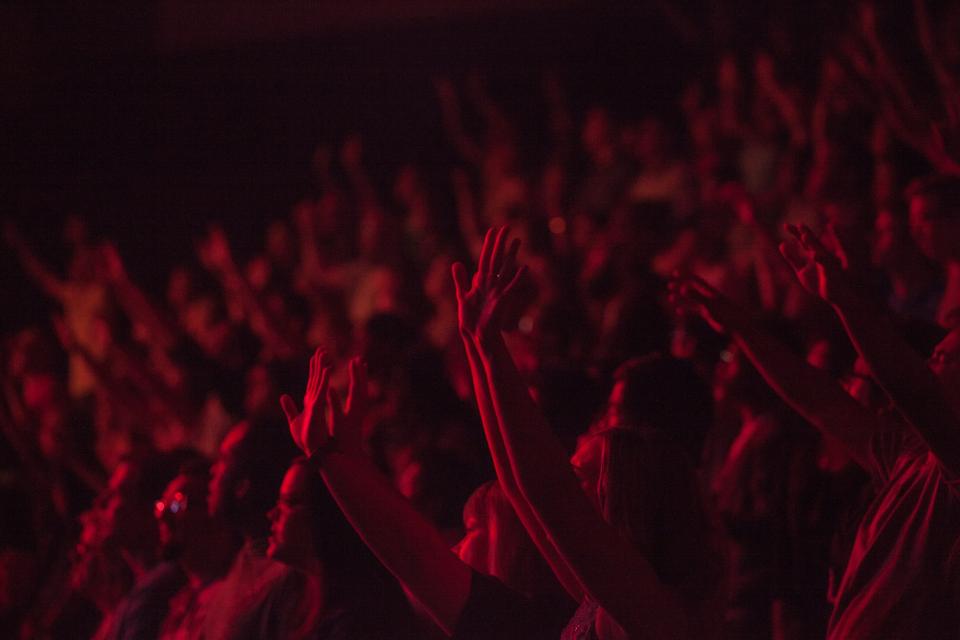Can You Captivate Your Audience In 30 Seconds Or Less?

Today’s tip is to engage your audience early.
To accomplish this, you just need a strong opening. Crafting a strong opening is simple; it only requires a few words. Read on and I will show you how to do it.
A presentation is broken up into three main sections. We start with an opening; we continue with the body, and we end with a conclusion! Our opening is where the audience decides whether they are going to pay attention, arbitrarily nod their heads to seem polite, or tune us out.
For my math students out there, do you remember the bell curve? For those that don’t, it looks sort of like a fancy lowercase “n.” It is important to note that the peak is in the middle.
Think of a speech as an inverted bell curve.
The peak is now at the beginning. Here we have about 30 seconds to hook our audience. After that—as we move into the body—we tend to lose some of the crowd's attention.
Most of the time this has nothing to do with you. We can blame it on the average attention span of our fellow humans! :) As the speech progresses, the audience sometimes zones out until they hear, “Finally” or ”In conclusion, I’d like to say…” and they jump to the edge of their seats to try and salvage a small portion of our message.
There are several ways to get around that drop in audience attention; an engaging opening is one of them. It shows that you are confident and compelling! It makes people want to stay engaged. Here are a few ways to do it:
Provide an Outline: You will sometimes hear speakers say, “I have these three points to share with you,” or “Let’s talk about where we were in the past, where we are today, and where we plan to go in the future.” Structuring our talk this way creates a list in the minds of our listeners; lists are easy to comprehend and lets the audience know exactly where you are in the presentation. If we are aware of where you are, it is much more seamless to stay engaged.
Share a Story: Remember having a bedtime story read to you as a child. (I’m not the only one). Stories tap into that child-like part of us that wants to feel connected and entertained. You are re-living a moment and inviting the audience to experience it with you. This technique can be used virtually anywhere in a speech but works like a charm at the beginning!
Ask a Question: Did you notice that I asked a question in the title of this post (I just did it again)? The psychology behind questions is that they subconsciously elicit a response from our listeners. Think about the last time someone asked you a question. You likely responded in your head, even if you didn't respond out loud. It happens so quickly that we are not even aware of it. Humans crave closure; hearing answers to questions, or answering them ourselves, gives us that satisfying closure.
Use a statistic: Statistics are one of the most powerful tools for enhancing our communication. It indicates intelligence, and a willingness to research our topic. As a result, we appear more credible! Imagine hearing, “98% of the people that read these Linkedin posts show signs of persuasiveness, increased work performance, and interpersonal success.” Whether you believe it or not, the statement makes you want to take a closer look. Try this technique out the next time you are beginning a speech. Don’t forget to site your sources.
People often tell me that the beginning of their presentation creates the most anxiety for them. If you share a similar feeling, now you have a solid way to make it through those initial moments.
The next time you get up to speak, try capturing your audience’s attention from the moment you begin. Let me know how it works!
Many of you have told me that you have been enjoying these posts. I will be publishing a book for you soon to help you even further. Drop me a note at [email protected] if you want me to let you know when it is available. Also, email me if you have any questions in general. :)
Best,
Steve
To accomplish this, you just need a strong opening. Crafting a strong opening is simple; it only requires a few words. Read on and I will show you how to do it.
A presentation is broken up into three main sections. We start with an opening; we continue with the body, and we end with a conclusion! Our opening is where the audience decides whether they are going to pay attention, arbitrarily nod their heads to seem polite, or tune us out.
For my math students out there, do you remember the bell curve? For those that don’t, it looks sort of like a fancy lowercase “n.” It is important to note that the peak is in the middle.
Think of a speech as an inverted bell curve.
The peak is now at the beginning. Here we have about 30 seconds to hook our audience. After that—as we move into the body—we tend to lose some of the crowd's attention.
Most of the time this has nothing to do with you. We can blame it on the average attention span of our fellow humans! :) As the speech progresses, the audience sometimes zones out until they hear, “Finally” or ”In conclusion, I’d like to say…” and they jump to the edge of their seats to try and salvage a small portion of our message.
There are several ways to get around that drop in audience attention; an engaging opening is one of them. It shows that you are confident and compelling! It makes people want to stay engaged. Here are a few ways to do it:
Provide an Outline: You will sometimes hear speakers say, “I have these three points to share with you,” or “Let’s talk about where we were in the past, where we are today, and where we plan to go in the future.” Structuring our talk this way creates a list in the minds of our listeners; lists are easy to comprehend and lets the audience know exactly where you are in the presentation. If we are aware of where you are, it is much more seamless to stay engaged.
Share a Story: Remember having a bedtime story read to you as a child. (I’m not the only one). Stories tap into that child-like part of us that wants to feel connected and entertained. You are re-living a moment and inviting the audience to experience it with you. This technique can be used virtually anywhere in a speech but works like a charm at the beginning!
Ask a Question: Did you notice that I asked a question in the title of this post (I just did it again)? The psychology behind questions is that they subconsciously elicit a response from our listeners. Think about the last time someone asked you a question. You likely responded in your head, even if you didn't respond out loud. It happens so quickly that we are not even aware of it. Humans crave closure; hearing answers to questions, or answering them ourselves, gives us that satisfying closure.
Use a statistic: Statistics are one of the most powerful tools for enhancing our communication. It indicates intelligence, and a willingness to research our topic. As a result, we appear more credible! Imagine hearing, “98% of the people that read these Linkedin posts show signs of persuasiveness, increased work performance, and interpersonal success.” Whether you believe it or not, the statement makes you want to take a closer look. Try this technique out the next time you are beginning a speech. Don’t forget to site your sources.
People often tell me that the beginning of their presentation creates the most anxiety for them. If you share a similar feeling, now you have a solid way to make it through those initial moments.
The next time you get up to speak, try capturing your audience’s attention from the moment you begin. Let me know how it works!
Many of you have told me that you have been enjoying these posts. I will be publishing a book for you soon to help you even further. Drop me a note at [email protected] if you want me to let you know when it is available. Also, email me if you have any questions in general. :)
Best,
Steve

 RSS Feed
RSS Feed